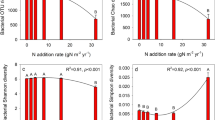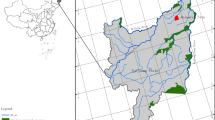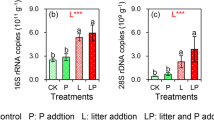Abstract
Nitrogen (N) and phosphorus (P) addition, either individually or in combination, has been demonstrated to enhance plant productivity in grassland ecosystems. Soil bacterial community, which is the driver of litter decomposition and nutrient cycling, is assumed to control responses of terrestrial ecosystem structure and function to N and P addition. Using a high-throughput Illumina MiSeq sequencing platform, we conducted a 9-year field experiment of N (0, 5, 10, and 20 g N m-2 yr-1) and P (0 and 10 g P m-2 yr-1) additions in the Inner Mongolian steppes to elucidate long-term effects of N and P addition on soil bacterial richness, diversity and composition. We found that N addition reduced the relative abundance of Acidobacteria, Chloroflexi, and Nitrospirae, while increased that of Bacteroides. The results showed that the bacterial biomarker was enriched in P addition treatments, either individually or combined with N addition. Both N and P addition altered the bacterial community structure, while only N addition greatly decreased bacterial richness and diversity. More importantly, we showed that all of these effects were most significant in N3P treatment (20 g N m-2 yr-1 and 10 g P m-2 yr-1), implying that P coupled with a high-level N addition exerted a great influence on soil bacterial community. Structural equation models revealed that N and P addition had a great direct effect on soil bacterial community and an indirect effect on it mainly by changing the litter biomass. Our findings highlighted that severe niche differentiation was induced by P along with a high-level N, further emphasizing the importance of simultaneously evaluating response of soil bacterial community to N and P addition, especially in the context of increasing anthropogenic nutrient additions.





Similar content being viewed by others
Explore related subjects
Discover the latest articles, news and stories from top researchers in related subjects.Data Availability
All data is in the article or in the supplementary material.
References
Bai Y, Wu J, Clark CM, Naeem S et al (2010) Tradeoffs and thresholds in the effects of nitrogen addition on biodiversity and ecosystem functioning: evidence from inner Mongolia Grasslands. Glob Chang Biol 16:358–372
Wu H, Yang J, Fu W et al (2023) Identifying thresholds of nitrogen enrichment for substantial shifts in arbuscular mycorrhizal fungal community metrics in a temperate grassland of northern China. New Phytol 237:279–294
Yuan Y, Li Y, Mou Z et al (2021) Phosphorus addition decreases microbial residual contribution to soil organic carbon pool in a tropical coastal forest. Glob Chang Biol 27:454–466
Sun Y, Wang C, Chen X et al (2022) Phosphorus additions imbalance terrestrial ecosystem C: N: P stoichiometry. Glob Chang Biol 28:7353–7365
Wardle DA, Bardgett RD, Klironomos JN et al (2004) Ecological linkages between aboveground and belowground biota. Science 304:1629–1633
Lu GB, Xie GA, Cagle X et al (2021) Effects of simulated nitrogen deposition on soil microbial community diversity in coastal wetland of the Yellow River Delta. Sci Total Environ 757:143825
Liu W, Jiang L, Yang S et al (2020) Critical transition of soil bacterial diversity and composition triggered by nitrogen enrichment. Ecology 101:e03053
Xia Z, Yang J, Sang C et al (2020) Phosphorus reduces negative effects of nitrogen addition on soil microbial communities and functions. Microorganisms
Ford H, Roberts A, Jones L (2016) Nitrogen and phosphorus co-limitation and grazing moderate nitrogen impacts on plant growth and nutrient cycling in sand dune grassland. Sci Total Environ 542:203–209
Tilman D, Wedin D (1991) Plant Traits and Resource Reduction for Five Grasses Growing on a Nitrogen Gradient. Ecology 72:1483–1483
Ramirez KS, Lauber CL, Knight R et al (2010) Consistent effects of nitrogen fertilization on soil bacterial communities in contrasting systems. Ecology 91:3463–3470 discussion 3503-3414
Isbell F, Reich PB, Tilman D et al (2013) Nutrient enrichment, biodiversity loss, and consequent declines in ecosystem productivity. Proc Natl Acad Sci U S A 110:11911–11916
Leff JW, Jones SE, Prober SM et al (2015) Consistent responses of soil microbial communities to elevated nutrient inputs in grasslands across the globe. Proc Natl Acad Sci U S A 112:10967–10972
Yang L, Wang N, Chen Y et al (2020) Carbon management practices regulate soil bacterial communities in response to nitrogen addition in a pine forest. Plant Soil 452:137–151
Preece C, Verbruggen E, Liu L et al (2019) Effects of past and current drought on the composition and diversity of soil microbial communities. Soil Biol Biochem 131:28–39
Wu MH, Li T, Zhang GS, Wu FS et al (2022) Seasonal Variation of Hypolithic Microbiomes in the Gobi Desert. Microb Ecol 85:1382–1395
Cui HY, Wei S, Manuel DB et al (2020) The effects of mowing and multi-level N fertilization on soil bacterial and fungal communities in a semiarid grassland are year-dependent. Soil Biol Biochem 151:108040
Li Y, Niu S, Yu G (2016) Aggravated phosphorus limitation on biomass production under increasing nitrogen loading: A meta-analysis. Glob Chang Biol 22:934–943
Fiere N, Lauber CL, Ramirez KS et al (2012) Comparative metagenomic, phylogenetic and physiological analyses of soil microbial communities across nitrogen gradients. ISME J 6:1007–1017
Zeng J, Liu X, Song L et al (2016) Nitrogen fertilization directly affects soil bacterial diversity and indirectly affects bacterial community composition. Soil Biol Biochem 92:41–49
Deforest JL, Donald R et al (2004) Atmospheric nitrate deposition, microbial community composition, and enzyme activity in northern hardwood forests. Soil Sci Soc Am J 68:132–138
Xu H, Su H, Su B et al (2014) Restoring the degraded grassland and improving sustainability of grassland ecosystem through chicken farming: A case study in northern China. Agric Ecosyst Environ 186:115–123
Li X, Zhu T, Peng F et al (2015) Inner Mongolian steppe arbuscular mycorrhizal fungal communities respond more strongly to water availability than to nitrogen fertilization. Environ Microbiol 17:3051–3068
Ling N, Chen D, Guo H et al (2017) Differential responses of soil bacterial communities to long-term N and P inputs in a semi-arid steppe. Geoderma 292:25–33
John MK (1970) Colorimetric determination of phosphorus in soil and plant materials with ascorbic acid. Soil Sci 109:214–220
Yance ED, Brookes PC, Jenkinson DC et al (1987) An extraction method for measuring soil microbial biomass C. Soil Biol Biochem 19(6):703–707
Quast C, Pruesse E, Yilmaz P et al (2012) The SILVA ribosomal RNA gene database project: Improved data processing and web-based tools. Nucleic Acids Res 41
Oksanen J, Blanchet F, Kindt R et al (2016) Vegan: community ecology package. R Package 2
Segata N, Izard J, Waldron L et al (2011) Metagenomic biomarker discovery and explanation. Genome Biol 12:R60
Wei T, Simko V (2021). R package 'corrplot': Visualization of a Correlation Matrix. (Version 0.92)
R Development Core Team (2014) R: a language and environment for statistical computing. R foundation for statistical computing, Vienna
Lefcheck JS (2016) piecewiseSEM: Piecewise structural equation modeling in R for ecology, evolution, and systematics. Methods Ecol Evol 7(5):573–579
Zhan J, Li Y, Zhao X et al (2023) Effects of nitrogen addition and plant litter manipulation on soil fungal and bacterial communities in a semiarid sandy land. Front Microbiol 14:1013570
Jones ML, Hodges G, Mills G (2010) Nitrogen mediates above-ground effects of ozone but not below-ground effects in a rhizomatous sedge. Environ Pollut 158:559–565
Luo YQ, Zhao XY, Ding JP et al (2020) Soil respiration dynamics in a semi-fixed sand dune under the pioneer shrub Artemisia halodendron Turcz. exBess. in the Horqin sandy land, northeastern China. Arid Land Res Manag 34:36–51
Lamb EG, Kembel SW, Cahill JF (2009) Shoot, but not root, competition reduces community diversity in experimental mesocosms. J Ecol 97:155–163
Ramirez KS, Craine JM, Fierer N (2012) Consistent effects of nitrogen amendments on soil microbial communities and processes across biomes. Glob Chang Biol 18:1918–1927
Wei C, Yu Q, Bai E et al (2013) Nitrogen deposition weakens plant-microbe interactions in grassland ecosystems. Glob Chang Biol 19:3688–3697
Yang HL, Li YL, Wang SK et al (2021) The response of critical microbial taxa to litter micro-nutrients and macro-chemistry determined the agricultural soil priming intensity after afforestation. Front Microbiol 12:730117
Fierer N, Bradford MA, Jackson RB (2007) Toward an ecological classification of soil bacteria. Ecology 88
Yang F, Zhang Z, Barberán A et al (2021) Nitrogen-induced acidification plays a vital role driving ecosystem functions: Insights from a 6-year nitrogen enrichment experiment in a Tibetan alpine meadow. Soil Biol Biochem 153
Song B, Li Y, Yang L et al (2023) Soil acidification under long-term N addition decreases the diversity of soil bacteria and fungi and changes their community composition in a semiarid grassland. Microb Ecol 85:221–231
Lucker S, Wagner M, Maixner F et al (2010) A Nitrospira metagenome illuminates the physiology and evolution of globally important nitrite-oxidizing bacteria. Proc Natl Acad Sci U S A 107:13479–13484
Yu C, Han F, Fu G (2019) Effects of 7 years experimental warming on soil bacterial and fungal community structure in the Northern Tibet alpine meadow at three elevations. Sci Total Environ 655:814–822
Madigan MT, Martinko JM, Dunlap PV et al (2009) Brock Biology of Microorganisms12th edn. Pearson Benjamin Cummings, Francisco. CA
Tian W, Wang L, Li Y et al (2015) Responses of microbial activity, abundance, and community in wheat soil after three years of heavy fertilization with manure-based compost and inorganic nitrogen. Agric Ecosyst Environ 213:219–227
Liu M, Li C, Xu X et al (2017) Organic and inorganic nitrogen uptake by 21 dominant tree species in temperate and tropical forests. Tree Physiol 37:1515–1526
Katharine, Coyte, Jonas et al (2015) The ecology of the microbiome: Networks, competition, and stability. Science 350:663–666
Delgado-Baquerizo M, Oliverio AM, Brewer TE et al (2018) A global atlas of the dominant bacteria found in soil. Science 359:320–325
Li W, Xie L, Zhao C et al (2022) Nitrogen Fertilization Increases Soil Microbial Biomass and Alters Microbial Composition Especially Under Low Soil Water Availability. Microb Ecol 86:536–548
Zhao C, Fu S, Mathew RP et al (2015) Soil microbial community structure and activity in a 100-year-old fertilization and crop rotation experiment. J Plant Ecol 8:623–632
Funding
This study was supported by the Key Science and Technology Program of Inner Mongolia (2021ZD001505), National Natural Science Foundation of China (32071845), Class A Strategic Priority Research Program of the Chinese Academy of Sciences (XDA23060404).
Author information
Authors and Affiliations
Contributions
Conceptualization: Yulin Li, Hongling Yang and Yongzhong Su; Methodology: Hongling Yang; Writing-original draft preparation: Hongling Yang; Writing-review and editing: Xiangwen Gong, Bo Yao, and Li Cheng. All authors have read and agreed to the published version of the manuscript.
Corresponding authors
Ethics declarations
Ethics Approval
Not applicable.
Consent to Participate
Not applicable.
Consent for Publication
Not applicable.
Competing Interests
The authors declare no competing interests.
Supplementary Information
ESM 1
(DOCX 260 kb)
Rights and permissions
Springer Nature or its licensor (e.g. a society or other partner) holds exclusive rights to this article under a publishing agreement with the author(s) or other rightsholder(s); author self-archiving of the accepted manuscript version of this article is solely governed by the terms of such publishing agreement and applicable law.
About this article
Cite this article
Li, Y., Yang, H., Su, Y. et al. Phosphorus Coupled with High Nitrogen Addition Exerts a Great Influence on Soil Bacterial Community in a Semiarid Grassland. Microb Ecol 86, 2993–3002 (2023). https://doi.org/10.1007/s00248-023-02297-5
Received:
Accepted:
Published:
Issue Date:
DOI: https://doi.org/10.1007/s00248-023-02297-5




